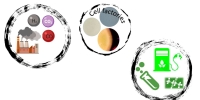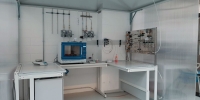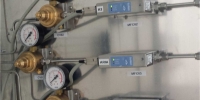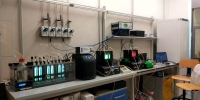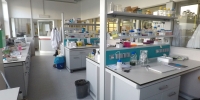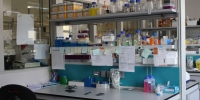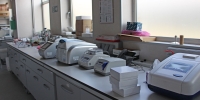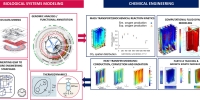Bioconversion of C1 gas streams into commodities
CO₂ biochemical conversion draws on the metabolic capabilities of particular microorganisms growing on gaseous substrates to construct bacterial cell factories for transforming the production of value-added compounds from renewable feedstocks and reducing our dependency on fossil fuels. We believe bio-factories will help to counteract the significant and accelerated climate change caused by greenhouse gases emitted by human activities. Resource-efficient and carbon-/climate-neutral bacterial cell factories can change the way we create energy, produce commodities and envisage industrial processing. The opportunities offered by the nature to build a better future are countless. Cell factory engineering focuses, in particular, on photosynthetic microorganisms, which get the power to capture and up-cycle carbon by light, and on gas fermenting microorganisms such as acetogens, methanotrophs and archaea.
Laboratories within the infrastructure
Bioconversion of C1 gas streams into commodities
CO₂ biochemical conversion supports the development of bio-based processes utilising C1 gasses for the production of platform chemicals with tangible environmental benefits.To repurpose the native cellular machinery for the production of desired end-products at appealing yields and productivities, our laboratory integrates systems biology, microbial physiology, biochemistry and fermentation technologies with strain engineering and multi-scale bioprocess modelling. To develop product-oriented proof-of-concept approaches into cell factories relevant to a resource efficient economy, stability and scalability of the engineered biocatalysts are of utmost relevance. The cross-sectoral skills deployed in our laboratory allow us to co-evolve process-related engineering solutions and strain development.
Our laboratory is designed to support users by means of the following platforms:
- Photonic cell factory lab - Light-powered carbon capture and upcycling through photosynthetic microorganisms
- Photosynthetic microorganisms such as cyanobacteria have garnered enormous interest as tools to capture light energy and CO₂ to synthesize value-added products. Advantageous factors are cyanobacterial genetic malleability, availability of metabolic engineering tools, competitive carbon conversion efficiency and native ability to grow in a very poor culture medium. The potential of cyanobacteria is being exploited in our lab to pursue the biobased production of marketable products by addressing the gaps that do exist in yields and productivity, in bacterial cultivation set-up and in the design/assembly/operation of market-oriented photobioreactors.
- Gas fermentation lab - Gas fermentation for commodity chemicals mediated by an ample array of microorganisms: acetogens, archaea, aerobic methanotrophs.
- The biocatalysts employed in the lab could integrate into climate-mitigating industrial pipelines and sustainably fuel the circular bioeconomy. The lab is primed to support the integration of acetogenic bacteria for the conversion of CO-rich industrial waste streams and synthetic gas mixtures (hydrogen, carbon monoxide and carbon dioxide) into cleantech processes of production of chemical intermediates associated with manifold industrial applications. Furthermore, the lab supports the exploitation of the metabolic potential of hydrogenotrophic methanogenic archaea, which are able to use H₂ for the reduction of CO₂ to produce biological methane, as well as of aerobic methanotrophs to develop innovative solutions in the energetic sector.
- Modelling lab – Multi-scale design and modelling of multi-scaled biotech processes.
- Multi-scale modelling allows to understand process performances at various scales (cell, fermenter unit, full process) and identify potential key solutions enabling risk reduction associated with biotechnological process.
- Collection and computational analysis of evidence-based relationships between biochemical, genome-scale and physiological data generated in biotech process is key to understand how engineering biology works. Metabolic modeling within a mathematical franewwork represents a chief support to the rational and predictable metabolic engineering of the cell factory for improving native and non-native biosynthetic pathways of interest on a case-by-case basis. Modelling of multi-physiscs phenomena taking place into the bioreactor can individuate and circumvent potential criticalities limiting the production performances. 3D multi-physics mathematical modelling is the toolbox of election to model different phenomena such as thermo-fluid dynamics, growth kinetics, mass transfer, light transmission (whenever required) and particle tracing.
- Owing to transversal capabilities, the lab forges custom predictive modelling services.
